All copyrights of this article are held by the author/s To cite this ...
All copyrights of this article are held by the author/s To cite this ...
All copyrights of this article are held by the author/s To cite this ...
Sie wollen auch ein ePaper? Erhöhen Sie die Reichweite Ihrer Titel.
YUMPU macht aus Druck-PDFs automatisch weboptimierte ePaper, die Google liebt.
Transaction<br />
Costs<br />
Commerce, Grundlagen, Strategien, Praxisbeispiele, Vahlen Verlag München,<br />
1999<br />
Transaction Costs / Transaktionskosten<br />
One <strong>of</strong> Coase’s (1937) original propositions was that firms and markets <strong>are</strong><br />
alternative governance structures that differ in <strong>the</strong>ir transactions costs. Under<br />
certain conditions <strong>the</strong> cost <strong>of</strong> organizing an exchange in a market exceeds<br />
<strong>the</strong> cost <strong>of</strong> coordinating <strong>the</strong> exchange in a firm. Transaction costs, in<br />
<strong>this</strong> context, consist <strong>of</strong> ex ante and ex post costs. In <strong>the</strong> market <strong>the</strong> ex ante<br />
costs include <strong>the</strong> expense <strong>of</strong> searching for a trading partner, specifying <strong>the</strong><br />
product(s) to be traded and - most importantly - negotiating <strong>the</strong> price and<br />
contract. The ex post transaction costs <strong>are</strong> incurred after <strong>the</strong> contract has<br />
been signed but before <strong>the</strong> entire transaction has been completed. These<br />
include late delivery, non-delivery or non-payment and - most importantly -<br />
problems <strong>of</strong> quality control (Casson 1987).<br />
Williamson added substantial precision to Coase’s argument <strong>by</strong> identifying<br />
<strong>the</strong> types <strong>of</strong> exchanges better conducted within <strong>the</strong> boundaries <strong>of</strong> a firm<br />
than within a market (e.g. Williamson 1975; 1986; 1991). Williamson suggests<br />
that transaction costs include both <strong>the</strong> direct costs <strong>of</strong> <strong>the</strong> transaction<br />
and <strong>the</strong> possible opportunity costs <strong>of</strong> infe-rior governance decisions. His<br />
framework rests on two main assumptions about human behavior (bounded<br />
rationality in a complex world and opportunism) and two key dimensions <strong>of</strong> a<br />
transaction (asset specificity, and uncertainty). The <strong>the</strong>ory fur<strong>the</strong>r recognizes<br />
that <strong>the</strong> operation <strong>of</strong> a market is not without cost as is assumed in<br />
classical economic <strong>the</strong>ory. The firm <strong>the</strong>n becomes a substitute for <strong>the</strong> market<br />
mechanism - created<br />
to reduce transaction costs.<br />
Sources:<br />
Casson 1987: Casson M.C.,<br />
The Firm and <strong>the</strong> Market: Studies in Multinational Enterprise and <strong>the</strong> Scope<br />
<strong>of</strong> <strong>the</strong> Firm, Cambridge MA: Press, 1987, reprinted in Casson M.C<br />
(ed.), Critical Writings in Economics - The Theory <strong>of</strong> <strong>the</strong> Firm, 72,<br />
Cheltenham UK: Edward Elgar Publishing, 1996.<br />
31<br />
Coase 1937: Coase R.H., "The Nature <strong>of</strong> <strong>the</strong> Firm", Economica, 4 (13-16),<br />
November 1937, pp. 386-405.<br />
Williamson 1975: Williamson O.E.,<br />
Markets and Hierarchies - Analysis and Antitrust Implications, New York:<br />
The Free Press, 1975.<br />
Williamson 1991: Williamson O.E.,<br />
"Comparative Economic Organization: The Analysis <strong>of</strong> Discrete Structural<br />
Alternatives", Administrative Science Quarterly, 36 (2), June 1991, pp. 269-<br />
296.<br />
Value Web Value Web<br />
Wertschöpfungsnetz<br />
1. Geschäftsverkehr<br />
Die Firma, oder allgemeiner: der wirtschaftliche Agent (Mensch, Organisation,<br />
Maschine) tauscht Informationen und Güter oder Leistungen über<br />
Plattformen, d.h. Medien, mit anderen Agenten aus. Diese Austauschprozesse<br />
bilden die Wertschöpfungskette (Value Chain). Das Bild<br />
31


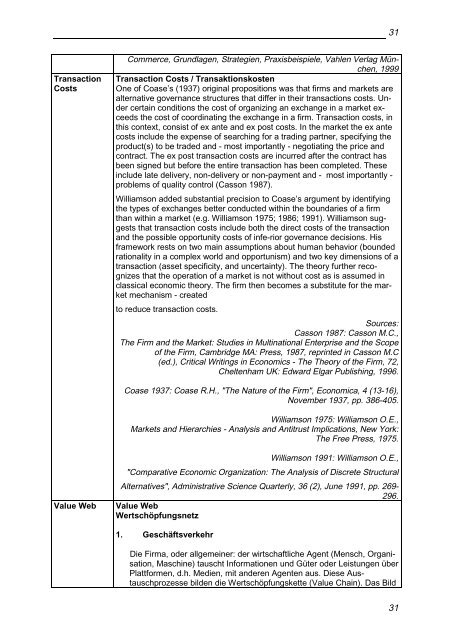


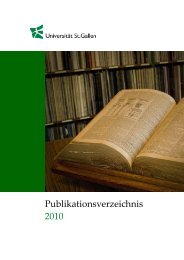

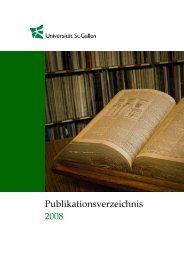

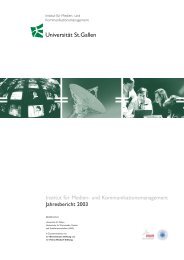
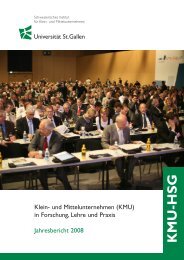
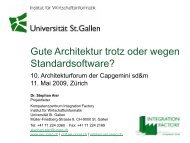
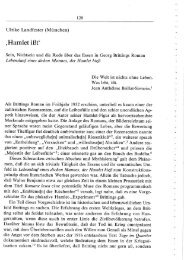
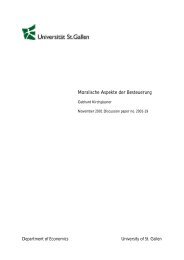

![[pdf] Blickpunkt Nr. 14/06 - Alexandria - Universität St.Gallen](https://img.yumpu.com/6499286/1/184x260/pdf-blickpunkt-nr-14-06-alexandria-universitat-stgallen.jpg?quality=85)
